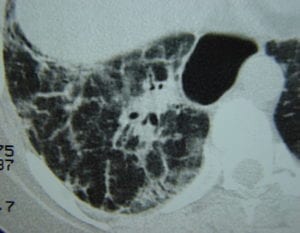Systemic Scleroderma
What is systemic scleroderma?
Systemic scleroderma, also known as systemic sclerosis, is an autoimmune disorder characterized by the thickening of the skin because of a buildup of scar tissue (fibrosis) in the skin and internal organs. There are different kinds of scleroderma, including localized scleroderma, which only affects specific parts of the body, and systemic scleroderma, which can affect the skin and internal organs. This page only addresses systemic scleroderma. To see an overview of scleroderma, click here. Systemic scleroderma is thought to affect between 40,000 and 165,000 people in the United States. It is four times more likely to affect females, and symptoms frequently begin in the middle years of life.What are the symptoms of systemic scleroderma?
The following are characteristic symptoms of systemic scleroderma:- Hardening and tightening of patches of skin (fibrosis)
- Raynaud’s phenomenon: color changes—blue and white—in the fingers and sometimes toes in response to cold temperatures
- Swelling in fingers and hands
- Open sores on the fingers
- Painful bumps, or calcium deposits, under the skin
- Heartburn
- Difficulty swallowing
- High blood pressure
- Kidney problems
- Shortness of breath
- Diarrhea
- Gastrointestinal malfunction
- Joint pain
What causes systemic scleroderma?
Autoimmune disorders occur because the body’s immune system wrongly attacks healthy tissue. Still, the exact cause of systemic scleroderma is not known. Most cases are sporadic, meaning they are not inherited from family. Researchers have studied various genes that may influence the risk of developing the disease if they mutate, but how they do so is still unknown. The major symptom, fibrosis (buildup of scar tissue), occurs when there’s an excess creation of a tough protein called collagen, which normally strengthens connective tissue in the body.How is systemic scleroderma diagnosed?
Systemic scleroderma is diagnosed using the following procedures:- Thorough physical examination
- Blood tests
- Biopsy
- X-rays
- Breathing tests
- Echocardiogram of the heart
- CT scan of the lungs
What are the treatments for systemic scleroderma?
There is no cure for systemic scleroderma, but treatment can control and minimize the symptoms. They include:- Medications to mitigate fibrosis, like D-penicillamine and cholchicine
- Blood pressure medications
- Drugs that suppress the immune system
- Medications that reduce stomach acid
- Antibiotics to prevent infection
- Pain relief medication
- Physical therapy
- Occupational therapy
- Surgery
Where can I find out more about systemic scleroderma?
Systemic Scleroderma Articles



CABA-201 for Systemic Sclerosis Earns Orphan Drug Designation
Jessica Lynn
March 26, 2024
Read More »

Higher PLR and PHR Linked to Worse Systemic Sclerosis Activity
Jessica Lynn
March 14, 2023
Read More »

Belimumab Granted Orphan Drug Designation for Systemic Sclerosis
Jessica Lynn
February 14, 2023
Read More »

Systemic Scleroderma Patient Pursues Ambitions as an Artist
James Moore
February 6, 2023
Read More »

Study of the Week: Black Scleroderma Patients are at a Greater Risk of Renal Crisis
James Moore
December 20, 2021
Read More »

A Study Finds Scleroderma Renal Crisis is More Common Among Black People
Rose Duesterwald
December 17, 2021
Read More »



